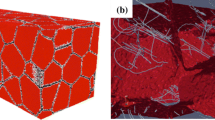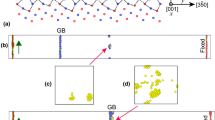Abstract
Cu90Ag10 alloys were subjected to severe plastic deformation at temperatures ranging from 25 to 400 °C and strain rates ranging from 0.1 to 6.25 s−1 using high-pressure torsion. The deformed samples were characterized by x-ray diffraction, transmission electron microscopy, and atom-probe tomography. A dynamic competition between shear-induced mixing and thermally activated decomposition led to the self-organization of the Cu–Ag system at length scales varying from a few atomic distances at room temperature to ≈50 nm at 400 °C. Steady-state microstructural length scales were minimally affected by varying the strain rate, although at 400 °C, the grain morphology did depend on strain-rate. Our results show that diffusion below 300 °C is dominated by nonequilibrium vacancies, and by comparison with previous Kinetic Monte Carlo simulations [D. Schwen et al., J. Mater. Res. 28, 2687–2693 (2013)], their concentration could be obtained.










Similar content being viewed by others
References
A. Gholinia, P.B. Prangnell, and M.V. Markushev: The effect of strain path on the development of deformation structures in severely deformed aluminum alloys processed by ECAE. Acta Mater. 48(5), 1115 (2000).
K. Nakashima, Z. Horita, M. Nemoto, and T.G. Langdon: Influence of channel angle on the development of ultrafine grains in equal-channel angular pressing. Acta Mater. 46(5), 1589 (1998).
N. Tsuji, Y. Saito, S-H. Lee, and Y. Minamino: ARB (accumulative roll-bonding) and other new techniques to produce bulk ultrafine grained materials. Adv. Eng. Mater. 5(5), 338 (2003).
R. Valiev: Nanostructuring of metals by severe plastic deformation for advanced properties. Nat. Mater. 3(8), 511 (2004).
A. Bachmaier, M. Kerber, D. Setman, and R. Pippan: The formation of supersaturated solid solutions in Fe–Cu alloys deformed by high-pressure torsion. Acta Mater. 60(3), 860 (2012).
M. Dao, L. Lu, R.J. Asaro, J.T.M. De Hosson, and E. Ma: Toward a quantitative understanding of mechanical behavior of nanocrystalline metals. Acta Mater. 55(12), 4041 (2007).
B.L. Huang, R.J. Perez, E.J. Lavernia, and M.J. Luton: Formation of supersaturated solid solutions by mechanical alloying. Nanostruct. Mater. 7(1–2), 67 (1996).
J.Y. Huang, Y.D. Yu, Y.K. Wu, D.X. Li, and H.Q. Ye: Microstructure and nanoscale composition analysis of the mechanical alloying of FeXCu100-X (X = 16, 60). Acta Mater. 45(1), 113 (1997).
V.V. Popov, E.N. Popova, and A.V. Stolbovskiy: Nanostructuring Nb by various techniques of severe plastic deformation. Mater. Sci. Eng., A 539, 22 (2012).
X. Quelennec, A. Menand, J.M. Le Breton, R. Pippan, and X. Sauvage: Homogeneous Cu–Fe supersaturated solid solutions prepared by severe plastic deformation. Philos. Mag. 90(9–10), 1179 (2010).
C.A. Schuh, T.G. Nieh, and H. Iwasaki: The effect of solid solution W additions on the mechanical properties of nanocrystalline Ni. Acta Mater. 51(2), 431 (2003).
R.B. Schwarz and C.C. Koch: Formation of amorphous alloys by the mechanical alloying of crystalline powders of pure metals and powders of pure metals and powders of intermetallics. Appl. Phys. Lett. 49(3), 146 (1986).
T. Klassen, U. Herr, and R.S. Averback: Ballmilling of systems with positive heat of mixing: Effect of temperature in Ag-Cu. Acta Mater. 45(7), 2921 (1997).
F. Delogu, M. Pintore, S. Enzo, F. Cardellini, V. Contini, A. Montone, and V. Rosato: Mechanical alloying of immiscible elements: Experimental results on Ag-Cu and Co-Cu. Philos. Mag. B 76(4), 651 (1997).
C. Gente, M. Oehring, and R. Bormann: Formation of thermodynamically unstable solid solutions in the copper-cobalt system by mechanical alloying. Phys. Rev. B: Condens. Matter 48(18), 13244 (1993).
E. Ma and M. Atzmon: Phase transformations induced by mechanical alloying in binary systems. Mater. Chem. Phys. 39(4), 249 (1995).
S.N. Arshad, T.G. Lach, M. Pouryazdan, H. Hahn, P. Bellon, S.J. Dillon, and R.S. Averback: Dependence of shear-induced mixing on length scale. Scr. Mater. 68(3–4), 215 (2013).
M. Pouryazdan, D. Schwen, D. Wang, T. Scherer, H. Hahn, R.S. Averback, and P. Bellon: Forced chemical mixing of immiscible Ag-Cu heterointerfaces using high-pressure torsion. Phys. Rev. B: Condens. Matter Mater. Phys. 86(14), 144302 (2012).
P. Bellon, R.S. Averback, S. Odunuga, Y. Li, P. Krasnochtchekov, and A. Caro: Crossover from superdiffusive to diffusive mixing in plastically deformed solids. Phys. Rev. Lett. 99(11), 110602 (2007).
Y. Ashkenazy, N.Q. Vo, D. Schwen, R.S. Averback, and P. Bellon: Shear induced chemical mixing in heterogeneous systems. Acta Mater. 60(3), 984 (2012).
J. Xu, U. Herr, T. Klassen, and R.S. Averback: Formation of supersaturated solid solutions in the immiscible Ni-Ag system by mechanical alloying. J. Appl. Phys. 79(8,Pt. 1), 3935 (1996).
M. Wang, R.S. Averback, P. Bellon, and S. Dillon: Chemical mixing and self-organization of Nb precipitates in Cu during severe plastic deformation. Acta Mater. 62, 276 (2014).
M. Wang, N.Q. Vo, M. Campion, T.D. Nguyen, D. Setman, S. Dillon, P. Bellon, and R.S. Averback: Forced atomic mixing during severe plastic deformation: Chemical interactions and kinetically driven segregation. Acta Mater. 66, 1 (2014).
E. Ma, J.H. He, and P.J. Schilling: Mechanical alloying of immiscible elements: Ag-Fe contrasted with Cu-Fe. Phys. Rev. B: Condens. Matter 55(9), 5542 (1997).
E. Botcharova, J. Freudenberger, and L. Schultz: Mechanical alloying of copper with niobium and molybdenum. J. Mater. Sci. 39(16–17), 5287 (2004).
A. Da Pozzo, S. Palmas, A. Vacca, and F. Delogu: On the role of mechanical properties in the early stages of the mechanical alloying of Ag50Cu50 powder mixtures. Scr. Mater. 67(1), 104 (2012).
Z.C. Cordero and C.A. Schuh: Phase strength effects on chemical mixing in extensively deformed alloys. Acta Mater. 82, 123 (2015).
A.C. Lund and C.A. Schuh: Topological and chemical arrangement of binary alloys during severe deformation. J. Appl. Phys. 95(9), 4815 (2004).
N.Q. Vo, S. Odunuga, P. Bellon, and R.S. Averback: Forced chemical mixing in immiscible alloys during severe plastic deformation at elevated temperatures. Acta Mater. 57(10), 3012 (2009).
A. Hohenwarter, M. Faller, B. Rashkova, and R. Pippan: Influence of heat treatment on the microstructural evolution of Al-3 wt.% Cu during high-pressure torsion. Philos. Mag. Lett. 94(6), 342 (2014).
X. Sauvage, N. Enikeev, R. Valiev, Y. Nasedkina, and M. Murashkin: Atomic-scale analysis of the segregation and precipitation mechanisms in a severely deformed Al-Mg alloy. Acta Mater. 72, 125 (2014).
B.B. Straumal, A.S. Gornakova, O.B. Fabrichnaya, M.J. Kriegel, A.A. Mazilkin, B. Baretzky, A.M. Gusak, and S.V. Dobatkin: Effective temperature of high pressure torsion in Zr-Nb alloys. High Temp. Mater. Processes (Berlin, Ger.) 31(4–5), 339 (2012).
B.B. Straumal, S.G. Protasova, A.A. Mazilkin, O.A. Kogtenkova, L. Kurmanaeva, B. Baretzky, G. Schutz, A. Korneva, and P. Zieba: SPD-induced changes of structure and magnetic properties in the Cu-Co alloys. Mater. Lett. 98, 217 (2013).
K. Tugcu, G. Sha, X.Z. Liao, P. Trimby, J.H. Xia, M.Y. Murashkin, Y. Xie, R.Z. Valiev, and S.P. Ringer: Enhanced grain refinement of an Al-Mg-Si alloy by high-pressure torsion processing at 100 °C. Mater. Sci. Eng., A 552, 415 (2012).
A.P. Zhilyaev, S.N. Sergeev, and T.G. Langdon: Electron backscatter diffraction (EBSD) microstructure evolution in HPT copper annealed at a low temperature. J. Mater. Res. Technol. (2014). Ahead of print.
F. Ren, S.N. Arshad, P. Bellon, R.S. Averback, M. Pouryazdan, and H. Hahn: Sliding wear-induced chemical nanolayering in Cu-Ag, and its implications for high wear resistance. Acta Mater. 72, 148 (2014).
Y.Z. Tian, S.D. Wu, Z.F. Zhang, R.B. Figueiredo, N. Gao, and T.G. Langdon: Comparison of microstructures and mechanical properties of a Cu-Ag alloy processed using different severe plastic deformation modes. Mater. Sci. Eng., A 528(13–14), 4331 (2011).
Y.Z. Tian, Z.F. Zhang, and T.G. Langdon: Achieving homogeneity in a two-phase Cu-Ag composite during high-pressure torsion. J. Mater. Sci. 48(13), 4606 (2013).
Y.Z. Tian, J.J. Li, P. Zhang, S.D. Wu, Z.F. Zhang, M. Kawasaki, and T.G. Langdon: Microstructures, strengthening mechanisms and fracture behavior of Cu-Ag alloys processed by high-pressure torsion. Acta Mater. 60(1), 269 (2012).
Y.Z. Tian, S.D. Wu, Z.F. Zhang, R.B. Figueiredo, N. Gao, and T.G. Langdon: Microstructural evolution and mechanical properties of a two-phase Cu-Ag alloy processed by high-pressure torsion to ultrahigh strains. Acta Mater. 59(7), 2783 (2011).
Y. Saito, H. Utsunomiya, N. Tsuji, and T. Sakai: Novel ultra-high straining process for bulk materials-development of the accumulative roll-bonding (ARB) process. Acta Mater. 47(2), 579 (1999).
R.Z. Valiev, I.V. Alexandrov, Y.T. Zhu, and T.C. Lowe: Paradox of strength and ductility in metals processed by severe plastic deformation. J. Mater. Res. 17(1), 5 (2002).
C. Suryanarayana: Mechanical alloying and milling. Prog. Mater. Sci. 46(1–2), 1 (2000).
S. Zghal, R. Twesten, F. Wu, and P. Bellon: Electron microscopy nanoscale characterization of ball milled Cu-Ag powders. Part II: Nanocomposites synthesized by elevated temperature milling or annealing. Acta Mater. 50(19), 4711 (2002).
F. Wu, D. Isheim, P. Bellon, and D.N. Seidman: Nanocomposites stabilized by elevated-temperature ball milling of Ag50Cu50 powders: An atom probe tomographic study. Acta Mater. 54(10), 2605 (2006).
S. Odunuga, Y. Li, P. Krasnochtchekov, P. Bellon, and R.S. Averback: Forced chemical mixing in alloys driven by plastic deformation. Phys. Rev. Lett. 95(4), 045901 (2005).
D. Schwen, M. Wang, R.S. Averback, and P. Bellon: Compositional patterning in immiscible alloys subjected to severe plastic deformation. J. Mater. Res. 28(19), 2687 (2013).
A.P. Zhilyaev and T.G. Langdon: Using high-pressure torsion for metal processing: Fundamentals and applications. Prog. Mater. Sci. 53(6), 893 (2008).
P.H.R. Pereira, R.B. Figueiredo, Y. Huang, P.R. Cetlin, and T.G. Langdon: Modeling the temperature rise in high-pressure torsion. Mater. Sci. Eng., A 593, 185 (2014).
R.Z. Valiev, R.K. Islamgaliev, and I.V. Alexandrov: Bulk nanostructured materials from severe plastic deformation. Prog. Mater. Sci. 45(2), 103 (2000).
A. Einstein: Über die von der molekularkinetischen Theorie der Wärme geforderte Bewegung von in ruhenden Flüssigkeiten suspendierten Teilchen. Ann. Phys. 17, 549 (1905).
G. Martin and P. Bellon: Driven alloys. Solid State Phys. 50, 189 (1997).
O.C. Hellman, J.A. Vandenbroucke, J. Rusing, D. Isheim, and D.N. Seidman: Analysis of three-dimensional atom-probe data by the proximity histogram. Microsc. Microanal. 6(5), 437 (2000).
A.L. Patterson: The Scherrer formula for X-Ray particle size determination. Phys. Rev. 56(10), 978 (1939).
J.E. Hilliard: Conversion of intercept density to grain size. Met. Prog. 85(5), 99 (1964).
R.K. Linde: Lattice parameters of metastable Ag-Cu alloys. J. Appl. Phys. 37(2), 934 (1966).
R.A. Enrique and P. Bellon: Compositional patterning in systems driven by competing dynamics of different length scale. Phys. Rev. Lett. 84(13), 2885 (2000).
M. Militzer, W.P. Sun, and J.J. Jonas: Modeling the effect of deformation-induced vacancies on segregation and precipitation. Acta Metall. Mater. 42(1), 133 (1994).
S.H. Song, X.M. Chen, and L.Q. Weng: Solute diffusion during high-temperature plastic deformation in alloys. Mater. Sci. Eng., A 528(24), 7196 (2011).
H. Mecking and Y. Estrin: The effect of vacancy generation on plastic deformation. Scr. Metall. 14(7), 815 (1980).
Y. Chen, M. Bibole, R. Le Hazif, and G. Martin: Ball-milling-induced amorphization in NixZry compounds: A parametric study. Phys. Rev. B 48(1), 14 (1993).
The equilibrium vacancy concentration, like the vacancy jump frequency, is influenced by interphase boundaries, however, it has been calculated in the simulations.
N.Q. Vo, J. Schaefer, R.S. Averback, K. Albe, Y. Ashkenazy, and P. Bellon: Reaching theoretical strengths in nanocrystalline Cu by grain boundary doping. Scr. Mater. 65(8), 660 (2011).
E.I. Galindo-Nava and P.E.J. Rivera-Diaz-del-Castillo: Thermostatistical modelling of hot deformation in FCC metals. Int. J. Plast. 47, 202 (2013).
S.I. Hong and H.J. Kwon: Superplasticicity of Cu–16 at.% Ag microcomposites. J. Mater. Res. 16(06), 1822 (2001).
ACKNOWLEDGMENTS
The authors would like to acknowledge the financial support from National Science Foundation (DMR 10-05813) to carry out this research. The APT was performed at the Northwestern University Center for Atom-Probe Tomography (NUCAPT), which is supported by the National Science Foundation’s MRSEC Program (DMR-1121262). The research at TUD and KIT was financially supported by Deutsche Forschungsgemeinschaft (HA1344/22-2). The Austrian Science Fund FWF within the project No T512-N20 is thankfully acknowledged for supporting D.S.
Author information
Authors and Affiliations
Corresponding author
Rights and permissions
About this article
Cite this article
Arshad, S.N., Lach, T.G., Ivanisenko, J. et al. Self-organization of Cu–Ag during controlled severe plastic deformation at high temperatures. Journal of Materials Research 30, 1943–1956 (2015). https://doi.org/10.1557/jmr.2015.119
Received:
Accepted:
Published:
Issue Date:
DOI: https://doi.org/10.1557/jmr.2015.119




